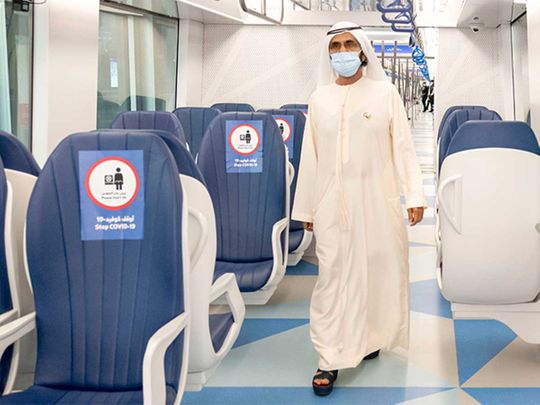
The greatest challenges of large modern cities of the world today are to take people from home to work and back faster and cheaper while reducing congestion on roads.
Prohibitive real estate cost keeps the working class away from city centres and the challenge is to bring them to commercial hubs every morning.
In the pre-metro era, Dubai was no different from other chaotic cities where highways resembled parking lots and commuters spent long hours on the road.
A symbol of progress and innovation, rapid mass transport systems have a bigger role than simply ferrying residents and visitors. Route 2020 and the wider metro system is the central piece of Dubai’s long term vision of embracing sustainability at all levels
This changed when Dubai launched a world-class automated rapid mass transport system ferrying tens of thousands daily. After briefly losing to Vancouver and Singapore, the emirate is now set to reclaim the title of the world’s largest driverless metro network.
Monumental feat
Beginning September, Dubai Metro will be ready to ferry commuters from Sharjah border to the tip of Dubai, a monumental feat achieved in just 11 years after the first train started rolling in September 2009.
The metro brought dramatic changes to the lives of people, reduced commuting time, eased traffic and connected residential clusters to commercial hubs, tourist spots and malls.
Now, a 15km long extension will connect more residential communities, industrial hubs and the Expo site. More importantly, this extension will reduce commuting time between Dubai International Airport and Al Maktoum International to just 60 minutes.
With this extension, Dubai Metro system will have a total of 54 stations on a 90 kilometre track zigzagging through congested localities, underground and under water.
Route 2020 will increase the total length of Dubai Metro’s Red and Green Lines to 90km and the total length of rail networks in the city will rise to 101km, including an 11km-long tram system.
The extension, announced 47 months ago, was completed as the world is fighting the pandemic, yet another example of the determination of Dubai’s leadership in pursuing strategic goals despite challenges.
“We say what we do and we do what we say. This is Dubai,” tweeted His Highness Shaikh Mohammad Bin Rashid Al Maktoum, Vice-President and Prime Minister of the UAE and Ruler of Dubai after inaugurating the Dh11 billion extension.
Almost 12,000 engineers and technicians worked for years to meet deadlines to build seven new stations, including three elevated and two underground.
A symbol of progress and innovation, rapid mass transport systems have a bigger role than simply ferrying residents and visitors. Route 2020 and the wider metro system is the central piece of Dubai’s long term vision of embracing sustainability at all levels.
After inaugurating the new route, Shaikh Mohammad said the UAE’s journey towards sustainable development is backed by quality projects and globally acclaimed infrastructure.
This metro route built by Roads and Transport Authority is yet another example of Dubai’s ability to deliver grand projects that match global benchmarks on quality and standards.







